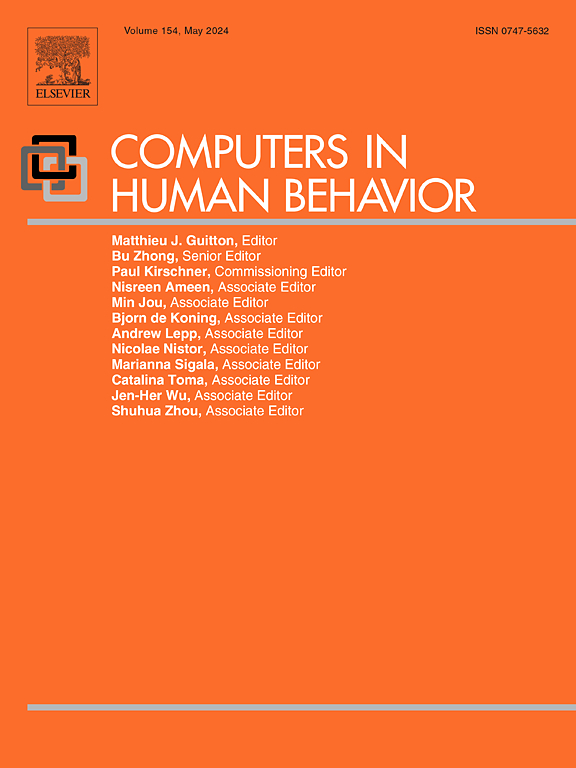黑人沉浸式虚拟:黑人用户在社交虚拟现实中的化身化和定制化的种族化体验
IF 9
1区 心理学
Q1 PSYCHOLOGY, EXPERIMENTAL
引用次数: 0
摘要
以往的研究揭示了桌面虚拟世界中的种族化身体验,但较少关注这种体验如何演变成更具沉浸感的社交虚拟现实(VR)媒介。利用交叉技术和虚拟身份差异模型作为框架,我们报告了两项互补研究的结果,旨在了解黑人用户在流行的社交虚拟现实平台 VRChat 上的化身体现体验。研究 1 利用访谈结果(n = 11)来考察黑人用户在这种沉浸式环境中如何驾驭、协商和应对基于虚拟化身的种族不平等和默认的白人身份。参与者在设计自己的数字外观时,承担了种族化的负担和身临其境的影响,包括化身故障、与化身创建者的种族化接触、依赖 DIY 解决方案(如学习化身创建),以及在选择自己的代表时有意识地考虑黑人虚拟身体的边缘化。研究 2 通过一项定量实验研究(n = 41)扩展了这些发现,该研究考察了黑人用户在社交 VR 中操纵其化身可见度时,身体和虚拟属性之间的差异如何影响他们的心理体验。头像差异与空间存在呈负相关,在没有虚拟镜子的情况下,头像差异与头像体现呈负相关。我们利用这些混合方法的研究结果,确定了社交虚拟现实中种族差异体现后果的新视角,强调了沉浸式体验的特权。通过以黑人用户的视角为中心,讨论对设计者和研究人员的影响,我们扩展了对社交 VR 和黑人虚拟性中种族边缘化用户多方面体验的头像研究。本文章由计算机程序翻译,如有差异,请以英文原文为准。
Black immersive virtuality: Racialized experiences of avatar embodiment and customization among Black users in social VR
Previous research has uncovered racialized avatar experiences in desktop virtual worlds, but less attention has been given to how this has evolved into the more immersive medium of social virtual reality (VR). Leveraging Intersectional Tech and the Virtual Identity Discrepancy Model as frameworks, we report on findings from two complementary studies aimed at understanding the avatar embodiment experiences of Black users on VRChat, a popular social VR platform. Study 1 draws on interview findings (n = 11) to examine how Black users navigate, negotiate, and respond to avatar-based racial inequity and defaults of whiteness in this immersive context. Participants took on racialized burdens and immersive repercussions when curating their digital appearance, including embodied glitches, navigating racialized encounters with avatar creators, relying on DIY solutions (e.g., learning avatar creation), and conscious consideration of the marginalization of Black virtual bodies when selecting their representation. Study 2 extends these findings with a quantitative experimental study (n = 41) that examined how the discrepancy between physical and virtual attributes influenced Black users' psychological experience in social VR while manipulating their avatar's visibility. Avatar discrepancy was negatively correlated with spatial presence and, in the absence of a virtual mirror, avatar discrepancy was negatively correlated with avatar embodiment. We use these mixed-methods findings to identify new perspectives on the embodied consequences of racial discrepancies in social VR, underscoring the privilege of immersion. By centering perspectives from Black users and discussing implications for designers and researchers, we expand avatar research on the multi-faceted experiences of racially marginalized users in social VR and Black virtuality.
求助全文
通过发布文献求助,成功后即可免费获取论文全文。
去求助
来源期刊

Computers in Human Behavior
Multiple-
CiteScore
19.10
自引率
4.00%
发文量
381
审稿时长
40 days
期刊介绍:
Computers in Human Behavior is a scholarly journal that explores the psychological aspects of computer use. It covers original theoretical works, research reports, literature reviews, and software and book reviews. The journal examines both the use of computers in psychology, psychiatry, and related fields, and the psychological impact of computer use on individuals, groups, and society. Articles discuss topics such as professional practice, training, research, human development, learning, cognition, personality, and social interactions. It focuses on human interactions with computers, considering the computer as a medium through which human behaviors are shaped and expressed. Professionals interested in the psychological aspects of computer use will find this journal valuable, even with limited knowledge of computers.
 求助内容:
求助内容: 应助结果提醒方式:
应助结果提醒方式:


